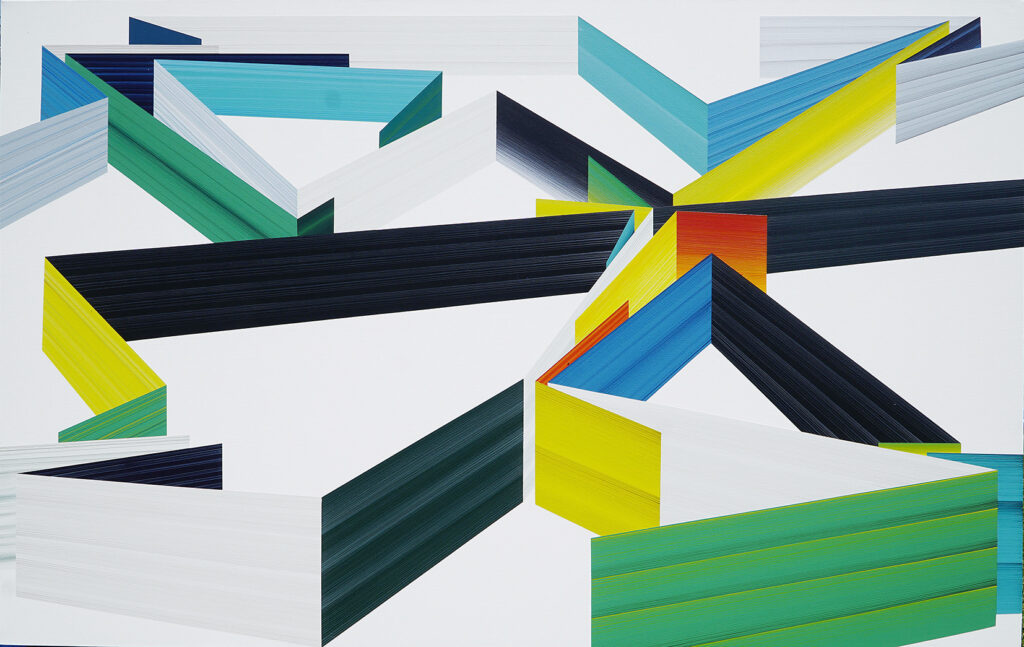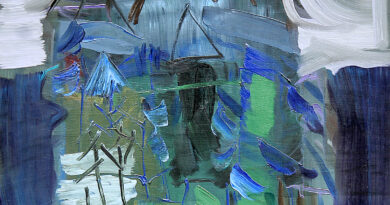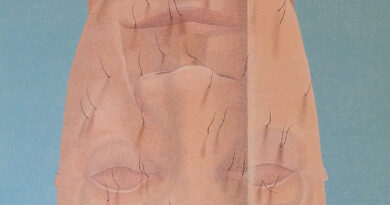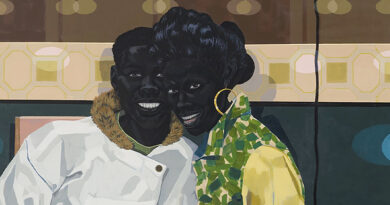a performance dedicated to structural integrity
INTERVIEW WITH HAYRİ ESMER / GÜLAY YAŞAYANLAR
We witness a chapter that canonizes vagueness and marginalizes our historical and cultural experiences and richness. This is the case particularly for our country. So to speak, it is a vanity fair that even does not bother to conceal its artificiality and can’t be genuine for all its efforts. It is a world that has never managed to be fair, but grown inconsistent, unreliable, weird and threatening… it is a world that never sees harm in marginalizing others. Such an environment naturally creates a chaotic vagueness and causes mental depression in individuals’ world. While taking on more than one role becomes natural, the artificiality among these personalities and personality clashes are normalized. This then enforces us to choose from among the diversifying range of downfall. And that exhibition was created on the basis of this multipartite and turbulent state of life as well as of the dialogue within that multipartite state. In other words, it was a fragmented state of a reality that lost its coherence that I wanted to highlight in the paintings.

Gülay Yaşayanlar -I t is great to see you again in İzmir after a long period of time. As far as we know your painting has been through a major structural change recently. First of all, can you tell us about this transformation and transition period?
Hayri Esmer – Thank you. It is my pleasure to be here again for a new exhibition after many years. About the change in my paintings… I am not sure about how much I will change from now on, but I want to see the change in art, particularly the one resulted from seeking to find out structures, as an understanding. That’s why; this understanding has been reflecting itself on my paintings since 1990s. At the beginning compositions with violence; works dedicated to hesitation and tension; gravure/engraved images, windows and so on… This last period, I feel, refers to a turning point. The enlargement of dimensions, spatial perception, establishment of the structural identity of color element and above all, the literal and coherent composition have been started to be considered as the character of this change. My painting has a character to create the effect first. It should be said that all of them I mentioned above are essential for a painting aiming to on take an impact. As a result of this, I want painting to win the audience, initiate conversation with them, and persuade them. All these considerations made the change inevitable and gradually enables the transition to a new identity.
The color element distinguishes itself in your paintings. Indeed, lines consisted of colors along with the interim colors are the significant structural elements constituting the context in painting. Keeping this in mind when we consider your aim to build up or create a painting in cause and effect relationship context, what do you say about the relationship between sense of color and composition?
I think that colour generates a strong energy though prejudicious and would like to make use of this energy. On the other hand, we witness a chapter in which perceptions were replaced by realities, which has been fed by a gorgeous vanity. Cities, streets, screens, and the life itself are place where we witness this variegation. I mean, colour is also one of the most important elements of the community of vanity and a reality that defines our current community, a case which is necessitated by a sociology that increasingly enforces publicity and which necessitates more efforts to sustain existence, which is gorgeous, flexible and dynamic. By this meaning, colour can also become a thing that set back or conceal what dramatic and tragic. I want not only to transform it into a sign that deciphers today’s tragedy but also conceals it, by which I mean, a structural element that reveals psychology of the community. That is, my preference for a particular colour is not a sympathy but, I must confess, has to do with spiritual and structural characteristics of a modern society. As for the relationship of colour with design, in my current paintings I am preferably in search of a colour that would make powerful the structural elements which have spaces but cover all the surface through drawing zigzags that cross one another. I would like to highlight this tension, intensity and acutance not only through these structural elements that form the architecture of the painting but also through colours and lines. In such a painting, colour constitutes the key means. We can even add light to this. The particular way I use colour, by which I mean the chromatic influence and sub-values that appear, includes the potentials of light in the painting. All in all, I make my paintings with the following question in mind “Can all the structural elements of the painting function as the conveyors of the meaning layers of life?”
Created space on canvas transforming continuously in an abstract cavity, while interacting with the suggested color values becomes your remark. The geometric shapes moving in cavity has a tense image that they surpass the restricted space which they are in and overflow from canvas. What would you say about the significant relational constructions, concepts and other things in your designs?
Well, a search for a painting that feels like it never ends and lasts forever has always been ingrained in my mind. For example, depth, intensity, space or infinity. These concepts have always occupied my mind and influenced the characters of my paintings. Meanwhile, your question reminded me of admiration for the series of Carceri d’Invenzione, previously known as the pioneering romantic paintings of Piranesi. I was immensely influenced by the infinitely lasting, embedded architecture and by the power of dreams as well as by the life-still deceptive feelings of the huge perspectives in those paintings. I even began to write about it. Piranesi had created in those intaglios limited in number a dysfunctional city of dreams with its terrific and huge places. A dead city… for all its glory, divinity, and eeriness…. Such paintings of his was actually a life metaphor that attributed to our captivity in this world. I now feel for a moment that I might have approached this dream of Piranesi. To be honest, in these paintings I had an already known common metaphor in mind. I wanted to fictionalise labyrinths within my own understanding of language and style. These labyrinths that form the boundaries also generated spaces across which one can wander. Labyrinths that are embedded, messy, and infinitely repetitive and that might give the impression of being randomly fictionalised and engraved in minds. With its embedded style, spaces that offer a relatively freedom… Transformative and ceaselessly repetitive spaces that offer freedom and limits simultaneously and always has an exit… It is actually envisioning of the world stuck in spiritual crisis and of cultural environment in which we live. However, it is also apparent that these paintings are fictional and artificial, thereby enabling the audience to exert imaginary intervention. They are also like a playground that inspires the audience. I wanted to create spaces across which the audience can be involved, can ‘wander’ and find places for themselves. In fact, there is already enough space in places for dreams of audience. I think by this aspect I lean on the romantic boundaries.
There is a touching genuine sensitiveness in your works. Don’t you think that this sensitiveness contrast with the effect of tension created by the stiffness of color space?
Yes, you might be right… Even from the very beginning, almost all my paintings were characterised by their structural contrasts and binaries. On the one hand, a lyricism inclined to touch the souls, on the other, a structural sharpness offered by geometry. I can’t give up either of them for now. I think I expect these contrasts and counterparts to enable the painting dynamic. I never thought of creating a painting that was not dynamic and sensational and whose tone of tension is low. On the one hand, a lyricism (which I can never give up) and a deep inspirational aspect with delicate and rigorous labour and on the other a solid structure sharpened by boundaries offered by geometry. That both of these qualities are basic things in our human nature and embarrass life from both ends and define it strengthens my interest in them.
In your previous exhibition you mentioned that being in a multipartite state is full of allusions to different time and space. Is “being in a multipartite state” equivalent to today’s mental decay or depression from a psychological perspective?
Of course, to me, we live in an era of a lasting crisis. We witness a chapter that canonizes vagueness and marginalizes our historical and cultural experiences and richness. This is the case particularly for our country. So to speak, it is a vanity fair that even does not bother to conceal its artificiality and can’t be genuine for all its efforts. It is a world that has never managed to be fair, but grown inconsistent, unreliable, weird and threatening… it is a world that never sees harm in marginalizing others. Such an environment naturally creates a chaotic vagueness and causes mental depression in individuals’ world. While taking on more than one role becomes natural, the artificiality among these personalities and personality clashes are normalized. This then enforces us to choose from among the diversifying range of downfall. And that exhibition was created on the basis of this multipartite and turbulent state of life as well as of the dialogue within that multipartite state. In other words, it was a fragmented state of a reality that lost its coherence that I wanted to highlight in the paintings. That is why, the paintings were created with a character that excludes homogeneity. I also made use of eclectic form of more than one canvas in these paintings. Creating a painting through multipartite structures as if it were a building… To create spatial and temporal characters in the paintings and make them central to the problems and the relations that grow layered. My main problem was these, to be honest.
It is remarkable that you voluntarily integrate colourful pieces into your work limitlessly but purposefully. These colourful pieces might be reflecting cultural layers or a number of images unique to the social structure like sub-cultures. It is as if fragmented structures forming a heterogeneous texture and placed side by side or one under the other were transformed into an attraction that encompasses a rationalism of unconscious phases. What would you tell us about this?
Yes. Good point. It is perhaps necessary to add to what I have already told the cultural layers and the relationship with sub-cultures. That is completely true. I have also been supporting this relationship with the way I use line. One should consider in this context that I want to transform lines into a mass by piling the superimposable cultural layers. This mass of monochrome lines with a depth traceable up to the lowermost layer gets blurred, disappears by melting, and loses it animacy substantially, which is related to the societal data. I had already highlighted this in ‘Sequential Patterns’ (Ardışık Örüntüler), in which I was in quest of a particular language. On the other hand, though my painting seems to have a mathematical design, there, I can say, exist dimensions of unconsciousness, randomisation, arbitrariness, and unpredictability. I exclude at all phases of painting the thought of accountability and normativeness in favour of the unidentified. This is because I believe that change, exploration, and experimentation are hidden in the structures that are unidentified or hard to identify. Therefore, it would not be surprising to find an attraction that also embodies rationalism.
Your paintings seem to be a coded process that encompasses design and production like an architecture. What are your thoughts on this systematic structuring, and linguistic and semiotic system?
There is no doubt that I want to use sharp stylistic margins, mass structures and spaces of the architecture. I find huge structures with extensive magnitudes supernal. The affection created by these structures seems to me to be a unique experience. I therefore make use of these. I don’t see a difference in terms of approach between a cumulatively-built architecture and the amalgamation of my forms, colours, and lines. I also create a painting as if I were constructing a building. Recently I have been trying to do this through similar materials too. The approach and process is like an entertaining game for me… As I consider the potentials created by such a language, I feel that my quest for new experimentations diversifies and my passion for producing grows apace. However, to me, this is an approach that structures, transforms, identifies its own dynamism and route during a process rather than an already-coded process. Hence, it is obvious that such a language system is highly preferred in artistic production with exclusion of conventional approach. This allows for the emergence of new tendencies, explorations, and alternatives; if the use of new materials is also a case, the range of alternatives broadens while the meaning-creation opportunities enrich.
I should explain this now; at this point, I don’t mean simple and predictable processes when I say ‘coded’. Rather I meant the possible infinite patterns and an attractive design generated through conscious coincidences. In these surfaces with possible infinite intersects, there is a ceaselessly transforming, sensitive structural unity. In addition, I consider this production to be a performance attributing to new modernist dynamics and to be woven by psychic codes. That is, in our environment in which concerns about the societal conditions are predominant, it could be that we need to deem this approach as being a philosophical action initiated due to intellectual concerns. What would you say?
Yes, it could be characterized so. However, for all these circumstances and concerns, I am interested in the boundaries of what I can do. My concern is whether I can do the best of what I can and should even in such a circumstance as an individual. In fact, there is something I do, but I am not sure either how appropriate it is. This could be more accurately assessed from outside. What I am concerned with is doubts, questions, anxieties, hesitation, and concerns. I begin painting in such a mode of thinking. These are the moments when I feel most tension. We are go through times when reliability is lost or what stands out hardly survives and has limited freedom of expression. Freedom, unfortunately, is now seen to think parallel to whoever is in power. We go through a period when individuals are judged by how much they try to adapt themselves to the pre-set codes rather than by their efforts to experience their own potentials and boundaries. Today, such concerns are intensified, and the spaces for thinking. Undoubtedly, I believe that the relationship of reality with art and a synthesised true affection should be of value. But does this suffice? This is also a usually a relative and controversial matter.
I would like to ask something relevant to these: We encounter in your works a visual ritual which seems to be far from issues and arguments such as sexuality, identity and ownership. With your approach, do you actually exhibit a performance that separates such arguments? Therefore, what would you tell us about the relationship of a preference for such an expression with intellectual and cultural environment or agenda?
This is really a complicated case… In fact, I am not creating a kind of art that is directly related to these problems, but I am definitely interested in them as an artist and educator and I don’t see myself far from these arguments. It did not surprise me that I seemed to be far from these arguments in my works, though. I think that this is a matter of preferences and priority. However, I can’t say that I don’t create artistic works that have political references and are related to the agenda within the boundaries of my own understandings as well as within such contexts. For instance, I created a monumental work in the memory of the attack in which 105 people were killed at Ankara train station in 2015 And there are also others which I haven’t exhibited yet… However, while I don’t keep away from such issues in the agenda, I find it more convincing to create an approach that prioritizes a multi-layered world of meaning and a deep spirituality. When I look back on my works, I see that I keep away from the world of materials, and direct expressions. I find images that are ambiguous and vague deeper and more exciting. I am of the opinion that such a thinking allows me to develop experimental opportunities and to use a language that is not confined to conventional boundaries of geometry, abstraction or minimalism. It could be that I find it more exciting not to be confined to either of these perspectives but to swing between these dilemmas.
Thank you.
(Translated by Kenan Dikilitaş, 2017)
Gülay Yaşayanlar, Copyright © 2022, Tüm hakları saklıdır. / All Rights Reserved.
Bkz. Hayri Esmer / Boşluk ve Sınır, Sergi Kataloğu, Kazım Türker Sanat Galerisi Yayınları, İzmir, Ocak 2018.
Hayri Esmer ile ilgili diğer yazılar:
https://saglamart.com/hayri-esmer-resminde-mekansal-duyumsama
https://saglamart.com/hayri-esmer-ile-gorusme-yapisal-butunluge-adanmis-duyarli-bir-performans



